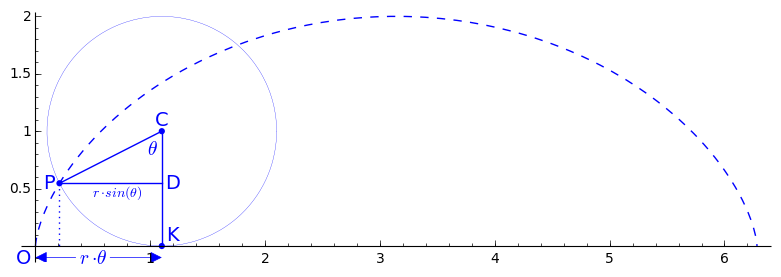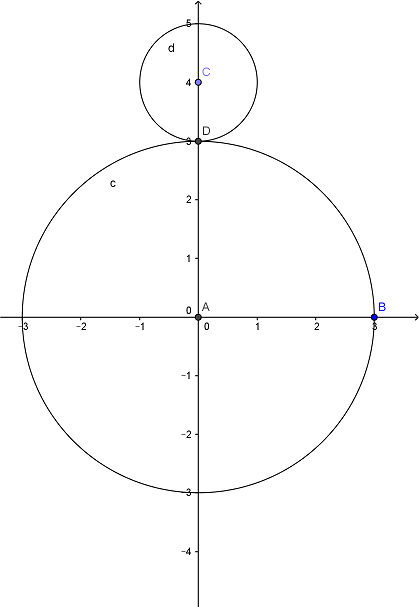Cycloid
The cycloid is a graphical function that results from following a point along the surface of a wheel as it rolls along a flat surface. When first I heard of this figure, I naively thought that it would be a half circle, but it doesn't take much investigation to determine that the path is far from circular. The cycloid is not semi-circular. It has no radius. Looking at Fig 1, the dashed line is the path taken by following any point, for example $P$, along the circles circumference as it rolls through one revolution. In the figure, point $P$ starts at the origin and after a short roll, it is at the position shown. We can find the coordinates of $P$.

- The arc length of the wheel, sector $PCK$, is $r\theta$ where $r$ is the wheel radius. We know this because the complete arc length is $2\pi r$ (circle circumference) and in that instance, the $2\pi$ is an angle, $\theta$. For any lesser angle, the same formula applies, it is the radius times the angle.
- Since the wheel arc length is $r\theta$ and since the Point $P$ was previously at the origin, the distance $OK$ must be $r\theta$ also. It is labelled as such.
- From the trig relations, we know that the distance $PD$ is $r\cdot sin(\theta)$ and in the figure it is labelled. That must mean that the $x$ coordinate of point $P$ is $r\cdot\theta-r\cdot sin(\theta)$.
- Line segment $CD$ is also identified from trig relations. $\left|CD\right|=r\cdot cos(\theta)$ and since $CK$ is the radius, $r$, the $y$ coordinate of $P$ (distance $DK$) must be $r-r\cdot cos(\theta)$.
- We have not only identified the coordinates of $P$, but also found them in a form that represents a parametric equation. That is, the parametric equation for a cycloid will be $$\left[\begin{array}{c} x\\ y \end{array}\right]=\left[\begin{array}{c} r\cdot(\theta-sin(\theta)\\ r\cdot(1-cos(\theta) \end{array}\right]$$

This is a trick question, related to the cycloid, but clearly not the same. The question is if we have two circles, one on top of the other and the top circle has $1/3$ the radius of the bottom circle, then if the top circle is rolled around the bottom circle, keeping their circumferences in contact, how many times will the top circle have revolved? See figure 2.
Answer: If the bottom circle is flattened into a line, as if it were a string, then the string length is its circumference which is $\pi D$. Since the circumference of the smaller circle is $\pi\cdot(D/3)$ then it would take exactly $3$ rotations to go from one end of the straightened string to the other. However, the bottom figure is a circle, not a straight line. As the smaller circle rotates around the larger, in addition to the rotations due to distance travelled, it also makes one additional full revolution to get back where it is! Thus the answer to this trick question is $4$ rotations. Indeed, where $n$ is the ratio of $(large\_circle/small\_circle)$, then the general answer will be $n+1$. To convince yourself, let the two circles be the same diameter, for example $2$ identical coins. Lay the coins on a table, hold one still and rotate the other one around. By the time we get to the bottom, the coin will have gone through $1$ complete revolution but only be half way around.